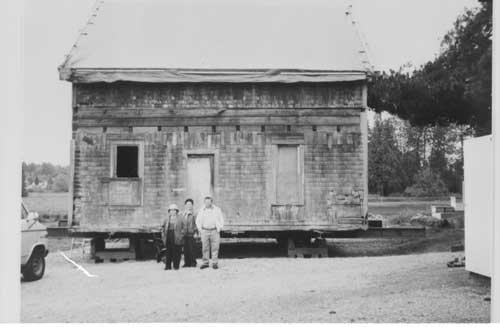BY Barb williams, EASTSIDE HERITAGE CENTER VOLUNTEER
Blueberry Facts:
Blueberries: genus Vaccinium.
Swamp blueberries: Vaccinium corymbosum prefer year-round wet acidic peat mixed with sand. Upland varieties: V. pennsylvanicum prefer acidic sandy soils subject to seasonal drought. The necessary presence of a root-fungus supplies nitrogen.
A Journal American 1996 article stated: blueberries are the only indigenous North American fruit grown in large commercial quantities; Washington produces about 6.2 million pounds of blueberries annually and ranks fifth behind Michigan, Maine, New Jersey and North Carolina in production. The oldest living blueberry bush (10,000 years) is located at Losh Run, Pennsylvania.
Children in blueberry field, Bellevue (2002.135.001)
Bellevue owns two major blueberry farms: The Overlake Blueberry Farm at the Mercer Slough; the Larsen Lake Blueberry Farm at Larsen Lake. Historically, indigenous peoples gathered wild blue huckleberries at Larsen Lake. Both Bellevue farms are organic (no pesticides or fertilizers), U-pick and sell produce. Roger Hoesterey, Bellevue City Parks Department and Resource Manager (1990s), helped preserve these lands as farmland ecology sites and for blueberry production. They total 36 acres (Larsen Lake/Blueberry Lake = 14, Overlake/Mercer Slough = 22), have approximately 24,000 plants that yielded an estimated average per year of 35,270 pounds of “U-pick” blueberries, and 8,594 pounds of “over the counter” blueberries from 2006 to 2016.
Blueberries are relatively easy to grow, harvest, transplant, store, pack, and ship making them a productive commercial crop.
Historic Perspective:
After extensive research, Louis Weinzril, a chemist and bacteriologist, bought a 45-acre farm in Bellevue (1944) on which to grow blueberries. He and his wife named the farm, Blueberry Lake Farm which was later renamed Larsen Lake to honor Ove Peter and Mary Larsen, the original owners. Louis planted nine varieties of blueberries and hired teenagers who were paid $600 to $1,000 a year. In 1957, they picked 50 tons of berries and shipped them to many states.
W.D. Sydnor, a horticulturalist for the Southern Railway, introduced blueberries to Bellevue in 1933 when he planted four acres of berries on his land at 108th just east of the current Barnes and Noble store. His plants came from all over including China, Maine and Florida. He could net a thousand dollars per acre, sold to the dinner trains and hired five to ten pickers. He believed upland blueberries, like his, were sweeter than swamp/bog blueberries. He grew nickel-sized berries and farmed from 1933 to 1944.
Overlake Blueberry label, 1947
M. Lee Dennison and Ernie Van Tine believed the blueberry would be the opportunity crop for the next half century, Puget Sound would become the greatest global blueberry-growing area and the Mercer Slough one of the most productive. In 1947 Dennison moved his Des Moines plants to the Mercer Slough and the Overlake Blueberry Farm was born. In the 1980s the City of Bellevue purchased the lands.
Different people have leased the Larsen Lake and Overlake blueberry farms from the City of Bellevue since the city purchased the lands in the 1940s and 1980s. Ted and Nancy Harding (1980-1994) and Bill Pace (2001-2016) worked the lands and managed the produce stands at the Overlake farm. A piano tuner, Tim Randall, leased the Larsen Lake farm (1984-1990). Dale Christensen of Christensen Farms worked the Larsen Lake and Overlake farms in 1999 with an expected yield of 140,000 pounds of berries. The Cha New Life Garden group of Cha Family Farms presently operates the fruit and produce stand at Larsen Lake. Currently, the City of Bellevue manages the crops for both farms.
Blueberry Festival Princess, Bellevue American, 1957
After World War II, the blueberry displaced the strawberry as the Bellevue fruit. The annual Blueberry Festival (1951 to 1961) replaced the Strawberry Festival. Blueberry pies and a Blueberry Festival Princess crowned the celebration. Arthur’s Bakery baked all the pies from 1957-1959 using Overlake Blueberry Farm berries in their recipe for “Arthur’s Blueberry Festival Pie”.
Today one can hear happy chatter in multiple languages among the blueberry bushes as people of all ages gather to pick, converse and experience the delights of outdoor activity. It is thanks to Bellevue and its visionaries that the blueberries and local farm history has been preserved for the public to enjoy.
Resources:
Eastside Heritage Center archives
Bellevue Parks and Community Resources
Blueberry Culture, Gardenology.org - Plant Encyclopedia and Gardening wiki
Eastside Heritage Center book, Images of America: Bellevue Post World War II Years. Arcadia Publishing 2014
Eastside Heritage Center book, Images of America: The East Side. Arcadia Publishing 2006
Knauss, Suzanne book, Culinary History of a Northwest Town - Bellevue, Washington. Eastside Heritage Center publishing 2007









